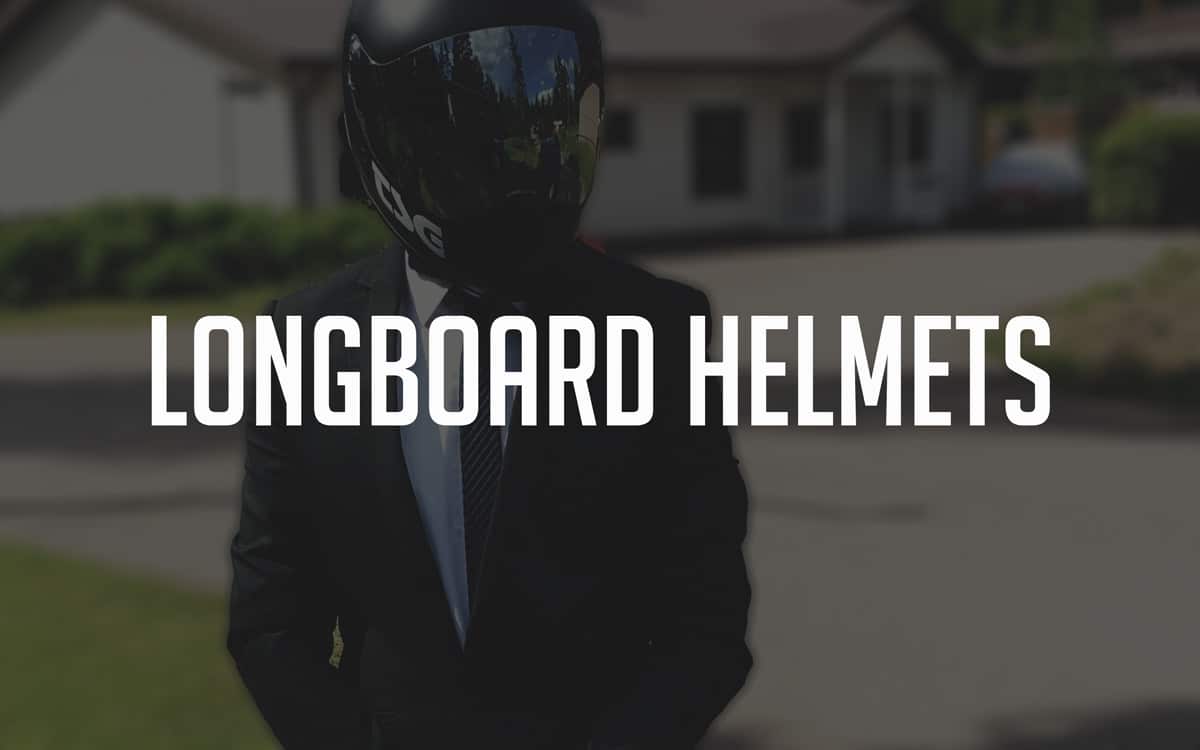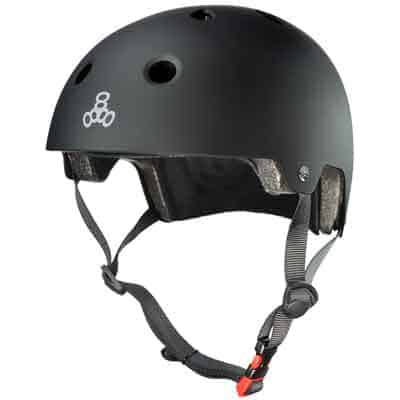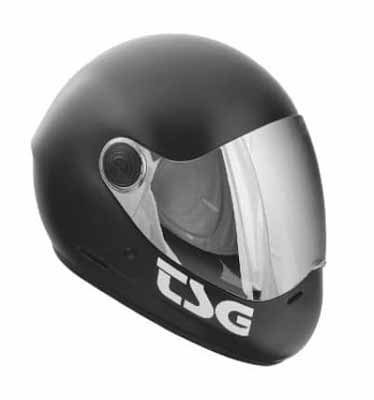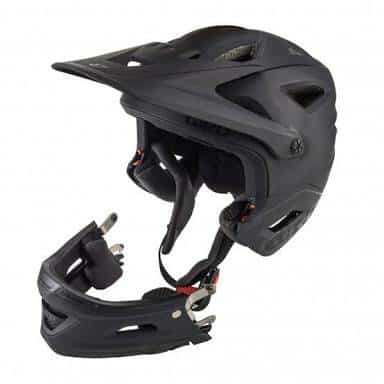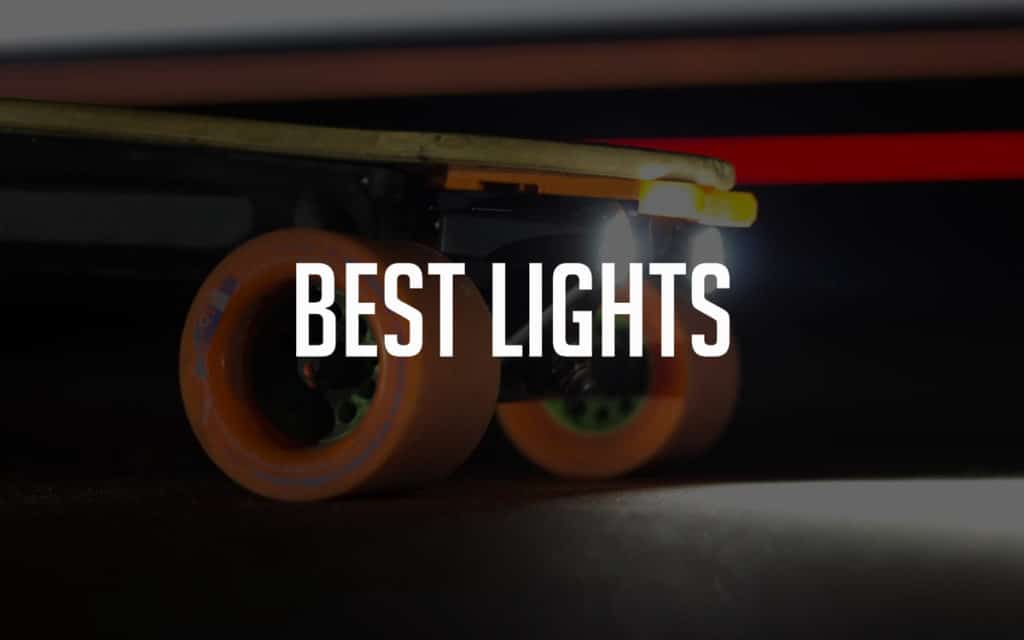We all know that the helmet is the most important means of protection when it comes to longboarding or any other type of skating, cycling or riding. However, many of us are left with a few, looming questions; What helmet is the best pick for us? At what end should we tug to make sure, without a shadow of a doubt, that this helmet fulfills the criteria that we expect the safety precaution to supply us.
Image | Model | Features | Check Price |
Best Value | Triple Eight Dual Certified |
| |
Best Full Face | TSG Pass |
| |
Best LED | Lumos Matrix |
| |
Best Convertible | Giro Switchblade |
|
What is the Best Full-face Helmet For Longboarding?
With certification by the International Downhill Federation on top of being ASTM F1952 and EN1078 rated, the undisputed best full-face helmet for longboarding and cycling is the TSG Pass. It can boast with the most number of certifications for any of its kind on the market. Add to that the liberal field of view and sleek design, you can bet that your badass factor raises exorbitantly as a bonus, simply by putting it on. I don’t know about you, but that’s a bonus that I can get behind!

Check out the “TSG Pass” on Amazon
What is the Best Half-shell Helmet for Longboarding?
The Triple 8 Dual Certified helmet is indeed dual certified as the name suggests, yet holds four other certifications on top of this. As such, it shouldn’t be a big surprise that the helmet has become one of the most popular helmets among skaters and BMX bikers, as well as being ranked among some of the best on the market.
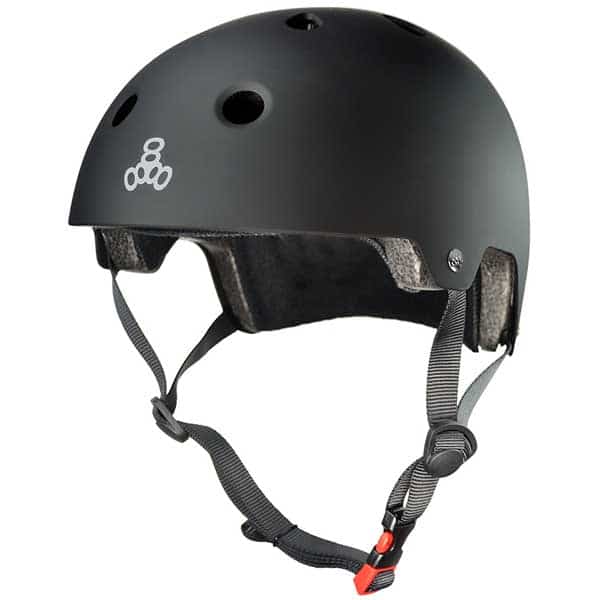
Check out the “Triple 8 Dual Certified” on Amazon
Why do we need to wear a Helmet when Longboarding?
To whoever of you hooligans fall into the category of not using a helmet when skating (I know who you are, Tom!), I highly advise you to utilize this article to find a suitable helmet! Just because the (highly dignified) act of wearing a helmet isn’t a law in most U.S states if you happen to be over the age of 18, doesn’t mean you should skip out! No matter the severity of a future injury, were it to happen, the helmet doesn’t only serve one singular purpose! Having worn a helmet can benefit you greatly in any personal injury case were you to find yourself having been in an accident. First and foremost, though, the helmet can be the difference between life and death, between a minor and a major collision, where it absorbs the impact your skull might have otherwise sustained.
What if I don’t want to look like a dork?
The notion that a helmet makes us look dumb has greatly overstayed it’s welcome. It’s a normal feeling to experience, but fortunately, helmets are coming back into style. In fact, some people might even label one a fool for not wearing a helmet.
A rad helmet is much easier to get ahold of nowadays than it was fifteen years ago. As long as you get a good, serious helmet with the right fit, there’s a high probability that you’ll look like an experienced skater, no matter if you’ve only been skating for a few months or a dedicated number of years. Many beginners find themselves buying cheap, ill-fitting helmets that do little to aid them properly in style, comfort or safety. As stated though, this can easily be remedied with professionally manufactured headgear!
What is the Best Longboard Helmet?
Get yourself a helmet that fits you, has the correct safety certifications and has a look you enjoy.
A worthy investment in a helmet is one of good quality and purchased in accordance with the size charts to ensure the best fit for maximum safety and comfort. This article will feature an arrangement of the best looking, highly certified and comfortable headgear that will keep you stylish in your day-to-day.
Best Full Face and Downhill Helmets for Longboarding
A helmet with full face protection is a great solution to avoid debris from passing vehicles getting kicked up in your face and as such it’s a preferable choice if you ride in an area with lots of traffic. Helmets of this nature protect you from all angles. If the headgear has a tinted visor, that also shelters your eyes from direct sunlight.
Fullface Helmet Certifications:
| CPSC Standard | EN 1078 | ASTM F1492 | ASTM F1952 | AS/NZS 2063 | |
|---|---|---|---|---|---|
| TSG Pass | ✓ | ✓ | ✓ | ||
| S1 Lifer Fullface | ✓ | ✓ | ✓ | ✓ | |
| Triple 8 Downhill Racer | ✓ | ✓ | ✓ | ||
| Predator DH6-X | ✓ | ✓ | |||
| Bell Sanction | ✓ | ✓ |
TSG Pass
The TSG Pass is an International down-hill Federation Certified helmet lined with ESP Impact Foam, an industry-standard in action sports that offers impact redistribution and prevents piercing to the helmet. The TSG Pass is lightweight in comparison to its surface area with a multi-layer fiberglass shell that is comparatively short in the front. This makes it a better fit for the head, lends comfort, higher safety. Thanks to the attention to detail, it’s a stylish pick.
The TSG Pass offers a wide viewing angle and is engineered with ventilation and anti-fog coating that ensures you can see at all times as well as giving extra comfort. It’s also fitted with ear slots to allow for better hearing and cheek pads that are adjustable to fit individually. The two spherically rounded visors, one electric silver and one clear, both offer complete UVA and UVB protection. Find out more about the TSG Pass in our review.
It’s ASTM F1952 and EN1078 rated, as well as being certified by the International Downhill Federation as the best Longboard Downhill helmet available on the market.

Price: $290 on Amazon
Price: €260 on their website
| Pros: |
| + Full-face construction protects your entire face |
| + Wide field of view |
| + 2 safety certifications |
| + considered as the Safest longboard downhill helmet by International Downhill Federation |
| Cons: |
| – Pricey |
| – often out of stock |
SIZE CHART – Measure around the forehead by wrapped the widest part of the head with a measuring device.
| Size | inch | cm |
| Small | 21.3 – 22” | 54 – 56 cm |
| Medium | 22 – 22.8” | 56 – 58 cm |
| Large | 22.8 – 23.6” | 58 – 60 cm |
| Extra Large | 23.6 – 24” | 60 – 61 cm |
S1 Lifer Fullface
S1 Lifer Helmet is a High- and Multiple impact certified helmet available on the market, which harbors breakthrough design of a CPSC and ASTM helmet while still offering the comfort of the soft foam non-certified counterparts. It has the feel, fit and protection of the Lifer Helmet but with full face coverage, making use of specially manufactured ESP Fusion Foam that protects from multiple force impacts.
- Specially formulated EPS Fusion Foam
- Certified Multi-Impact (ASTM)
- Certified High Impact (CPSC)
- 5x More Protective Than Regular Skate Helmets
- Deep Fit Design
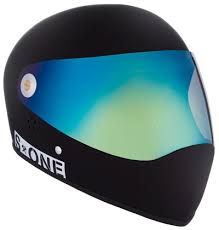
Price: $280-340 (dependent on style and size) on their Website
| Pros: |
| + Full-face construction protects your whole face |
| + wide field of view |
| + Dual Certified |
| Cons: |
| – Pricey |
Triple 8 Downhill Racer Helmet
The Triple 8 downhill racer helmet has a hand-laid fiberglass shell. It is fitted with a shatter-resistant flip-up visor specially designed to limit wind resistance. It has ESP Foam and velvet lining and comes with an extra pad insert so that you can customize the fit.
Meets CPSC 1203 bike and ASTM F1952 downhill mountain bike racing standards
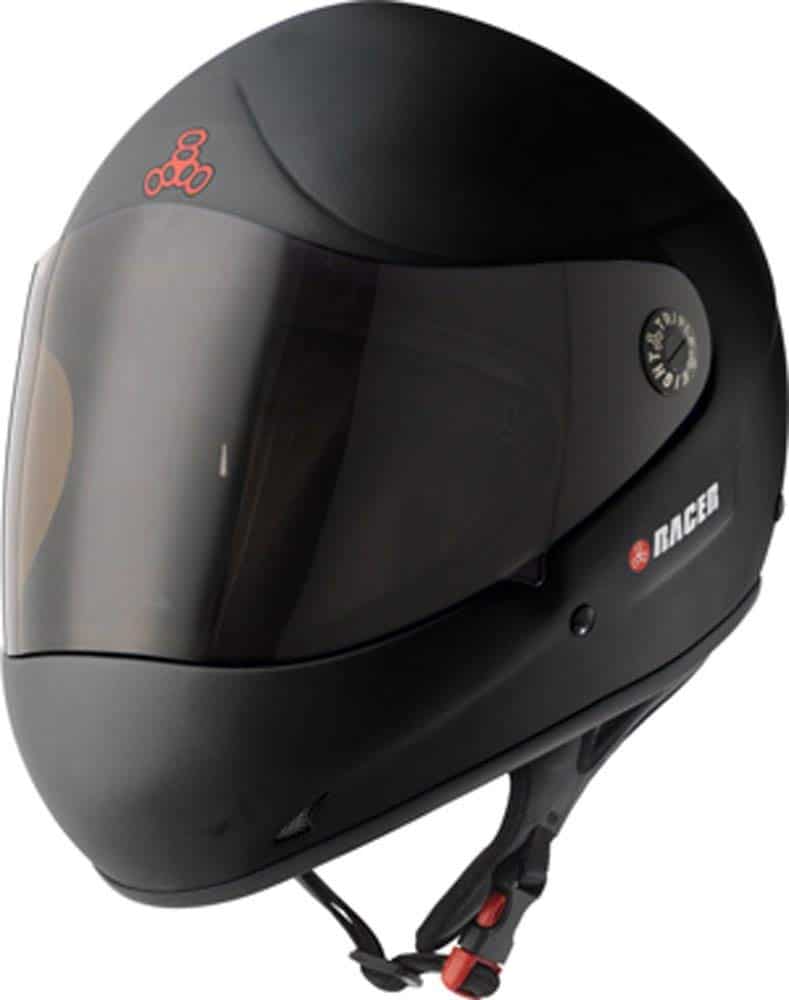
Price: $212 – $300 (size and style dependent)
Check it out on Amazon
SIZE CHART – To ensure a perfect fit, measure the circumference of your head starting in the middle of your forehead and match it with the sizes below:
| Size | inch | cm |
| XS/S | 18.9 – 21.3 in | 48 – 54 cm |
| S/M | 21.7 – 22.8 in | 55 – 58 cm |
| L/XL | 23.2 – 24 in | 59 – 61 cm |
| Pros: |
| + Full-face construction protects your whole face |
| + wide field of view |
| + Dual Certified |
| Cons: |
| – Lack of ventilation can cause fogging |
| – Pricey |
Predator DH6-X
Meets CPSC standard and is CE 1878 certified
The Predator DH6-X is designed with a full carbon shell, has EPS Foam, meets CPSC standard and CE-1878 certified. In comparison to their previous models, Predator has further designed this helmet with a substantial chin bar and back part for maximum impact protection. Besides being designed to ensure a good peripheral vision, it also features both a Silver Mirror visor and Black Tinted visor that are easy to switch between as the weather changes, no tools needed. It’s a One size fits all, modifiable to fit snugly to your head. Included with the helmet is a fit kit with a variety of helmet liners and cheek pads. Furthermore, the double D-ring chin strap further ensures maximum fit, comfort, and, of course, safety!
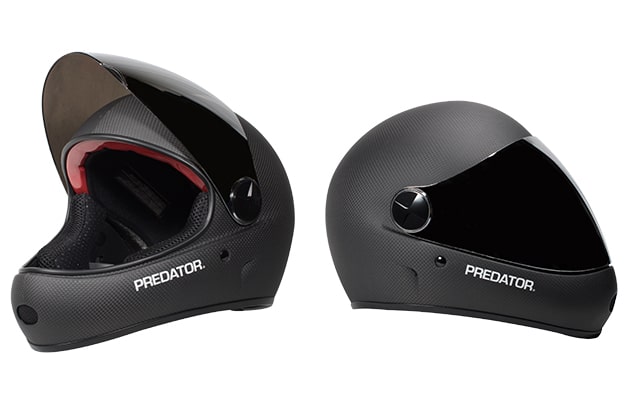
Price: $490.00
Check it out here on their website.
| Pros: |
| + Lightweight – only 875 gramm |
| + 2 safety certifications |
| + Attractive, minimalist design |
| + Comfortable – Well ventilated, anti-fog and great during any season |
| Cons: |
| – One size helmet | Customizable, but only one size |
| – No rear adjuster |
Bell Sanction
This Bell helmet is an ABS shell piece with an adjustable visor. It’s an economical option for you just starting out that are worried about safety. It is a lightweight helmet that runs smaller in its sizes, has a hand-laminated fiberglass shell and a minimalist design, and weighs in at 950g. While it’s not completely airtight, it’s a decent pick for longboarding, pricing under $100 despite being a full-face helmet! Made especially for juniors, this helmet is CE EN1078 and CPSC Bicycle certified.
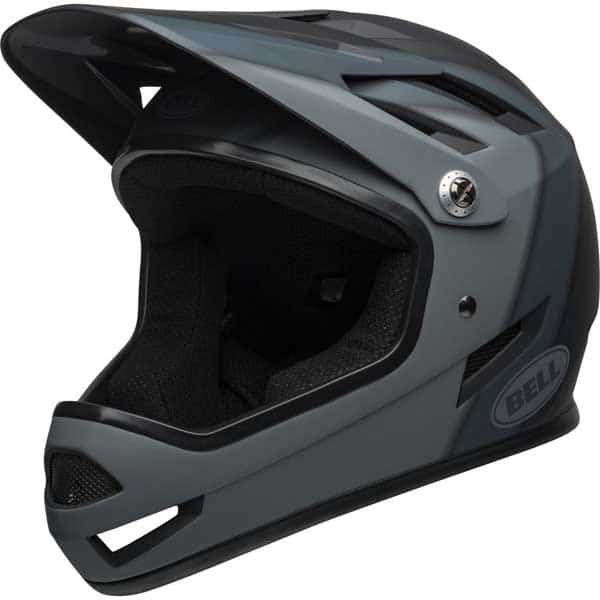
Price: $90
Check it out on Amazon
| Pros: |
| + Affordable full-face helmet |
| + 15 vents (perfect for summer rides) |
| + CE ENC1078 and CPSC certified |
| Cons: |
| – Lack of sizes – Small sizes |
| – Some users report it being uncomfortable for long rides |
Best Convertibles for Longboarding
Convertible Helmet Certifications:
| CPSC Standard | EN 1078 | ASTM F1952 | MIPS Available | |
|---|---|---|---|---|
| Bell Super 3R | ✓ | ✓ | ✓ | |
| Giro Switchblade | ✓ | ✓ | ✓ | ✓ |
Bell Super 3R (MIPS)
The Bell Super 3R is an unusual compromise of versatility and protection with its removable chin bar to an otherwise full-face helmet. On dangerous terrain, one can simply take the chin bar out of their travel bag and strap it on in seconds, no tools needed. The Bell 3R has breakaway screws that are designed to snap away from the visor during a tough fall to avoid any damage to your neck. With the adjustable visor system and integrated breakaway camera mount, this headgear truly brings new meaning to versatility.
The Bell Super 3R MIPS has two safety certifications: CE EN1078, CPSC Bicycle
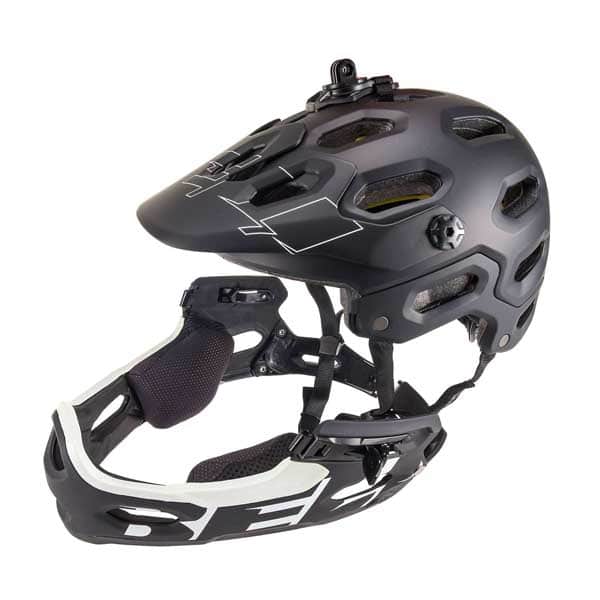
Price- $209.95 – $325.00 (size dependant)
Check the current price on Amazon here.
| Pros: |
| + Comes with MIPS |
| + Half-lid and full-face in one helmet |
| + Wide field of view |
| + 2 safety certifications |
| Cons: |
| – Does not have the highest certifications |
| – Does not provide the same protection as other full-face models |
SIZE CHART – Measure around the forehead by wrapping a measuring device around the widest part of the head.
| Size | inch | cm |
| Small | 20.5 – 22 inch | 52 – 56 cm |
| Medium | 21.7 – 23.2 inch | 55 – 59 cm |
| Large | 22.8 – 24.4 inch | 58 – 62 cm |
What is MIPS?
MIPS is a revolutionary new standard in helmet safety technology. It was developed by brain surgeons and scientists to reduce rotational forces during angled impacts to the head.
Giro Switchblade MIPS
The ATSM Downhill Certified full-face helmet Giro Switchblade MIPS functions similarly to the Bell Super 3R MIPS in many aspects, with its removable chin bar fit for travel storage coupled with the simple no-tool installation. This specially designed to conquer the rowdy, uncertain terrain at the times you need the added safety.
The biggest difference between the two helmets come down to ventilation. The Super Bell 3R MIPS has more ventilation holes and is therefore suited for those sunny, hot days. The Giro, while not ventilated, instead offers a greater means of protection.
The Giro Switchblade has three safety certifications: ASTM-1952-DH, CE EN1078, CPSC Bicycle — with and without the chin bar.

Price: $220 – $334 (Size dependent)
Check the current price on Amazon here.
| Pros: |
| + Comes with MIPS |
| + Half-lid and full-face in one helmet |
| + Wide field of view |
| + 3 safety certifications |
| + ATSM-Downhill certified |
| Cons: |
| – Lack of ventilation |
| – Pretty Heavy |
| – Does not provide the same protection as other full-face models do |
SIZE CHART – To determine the correct helmet size, wrap a measuring tape around the head, keeping the tape just above the ears and level front to back. Use the guide along with the measurement to determine size.
| Size | inch | cm |
| Small | 20 – 21.65 in | 51 – 55 cm |
| Medium | 21.65 – 23.25 in | 55 – 59 cm |
| Large | 23.25 – 24.8 in | 59 – 63 cm |
Half-shell Helmet for Longboard
If you’re not riding seriously and don’t extend to high speed, or just hate the design and look of a full-face helmet, you should still wear at least a half-shell helmet when longboarding. Trust me on this, your future self will thank the current you. If you require a lightweight helmet that can offer certified protection without being too bulky and still look fashionable, read below.
Half-shell Helmet Certifications:
| CPSC Standard | EN 1078 | ASTM F1492 | AS/NZS 2063 | MIPS Available | |
|---|---|---|---|---|---|
| Triple 8 Dual Cert | ✓ | ✓ | ✓ | ✓ | |
| S1 Lifer | ✓ | ✓ | ✓ | ✓ | |
| Triple 8 Gotham | ✓ | ✓ | ✓ | ✓ | |
| Bern Watts | ✓ | ✓ | ✓ | ||
| Thousand Helmet | ✓ | ✓ | ✓ | ||
| Pro-Tec Classic Cert | ✓ | ✓ | ✓ | ✓ |
Triple 8 Dual Certified
The Triple 8 dual certified biking and skating helmet was manufactured with close attention to detail. They consulted experts in the field of longboarding, BMX, commuting and derby to ensure the ultimate shape fit and function. It complies with U.S CPSC Safety Standard for Bicycle Helmets for 5 years and older as well as ASTM F-1492-08 Safety Standard for skating. There is a model with the patented MIPS technology, developed to reduce damage from angled impacts, available.

Complies with CE EN 1078 – Helmets for pedal cyclists, skateboarders, and roller skaters and with AS/NZS 2063 – Bicycle Helmets
Price – $29.23 – $99.95 (size and MIPS included dependant)
Check the price here on Amazon.
| Pros: |
| + 4 times certified |
| + MIPS available |
| + Available in several colors |
| Cons: |
| – Sometimes too small (better size up) |
SIZE CHART – To ensure a perfect fit, measure the circumference of your head starting in the middle of your forehead and match it with the sizes below.
| Size | inch | cm |
| XS/S | 19.7 – 21.5 in | 50 – 55 cm |
| S/M | 21.5 – 22.75 in | 55 – 58 cm |
| L/XL | 22.75 – 24 in | 58 – 61 cm |
S1 Lifer
The S1 Lifer has Deep Fit Design, which means it sits lower than other helmets and offers more protection and a better fit. Many customers claim a large part of the comfort of the S1 Lifer comes down to this deep fit design. Further, the helmet comes with padding in all sizes so you can customize the fit. The S1 Lifer claims to have specially formulated ESP Fusion Foam that renders the helmet 5x more protective than other skating helmets on the market.
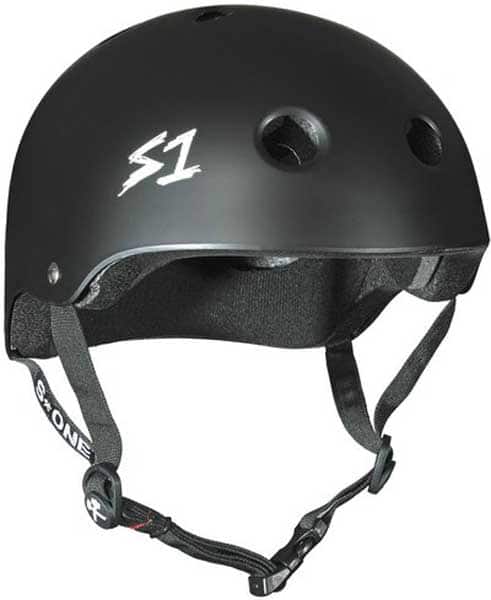
Price: $60
Check the price here on Amazon.
| Pros: |
| + High certified (Certified Multi-Impact [ASTM] and Certified High Impact [CPSC]) |
| + proven to be one of the safest helmets on the market |
| + Available in many colors |
| Cons: |
| – Sometimes too small (better size up) |
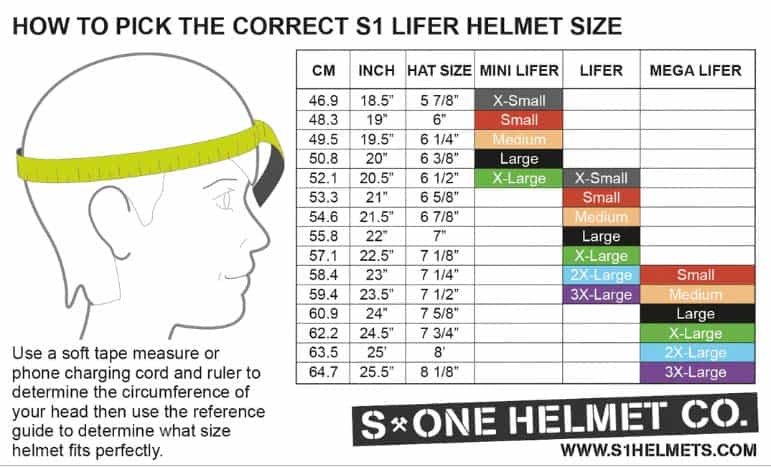
Triple Eight Gotham
The Dual Certified Gotham helmet now features MIPS technology, a low friction layer that absorbs a large part of the rotational force during a crash. The helmet features the patented Conehead EPS liner, Triple Eight logo vents and a slight brim. Few helmets match it in terms of comfort, safety and style when it comes to MIPS and Gotham’s. The Sweatsaver Fit Pads and its adjustable fit dial system with the reflective dial lend extra comfort and perfect fit. The grooved EPS allows for breeziness.
Dual Certified: Complies with U.S. CPSC Bike and ASTM Skate Safety Standards

Price: $ (size dependent)
Check the price here on Amazon.
| Pros: |
| + Dual certified |
| + trendy looking |
| + Great cold weather helmet |
| + MIPS available |
| Cons: |
| – No Air Vents – could be too hot in summer |
SIZE CHART – To ensure a perfect fit, measure the circumference of your head starting in the middle of your forehead and match it with the sizes below:
| Size | inch | cm |
| XS/S | 18.9 – 21.3 in | 48 – 54 cm |
| S/M | 21.7 – 22.8 in | 55 – 58 cm |
| L/XL | 23.2 – 24 in | 59 – 61 cm |
Bern Watts
With a hard visor inspired by the baseball hat, the dial-adjustable fit system, EPS/ABS construction and moisture-controlling premium liner, the classic Bern style of the Watts is a true all-season helmet. Perfect for the morning commute, the ski area or bike path alike and beating out both bike and snow safety certifications, this helmet both looks and feels great no matter the time or season!
- ALL-SEASON – Pick the model that best fits your style and customize your helmet with their range of seasonal upgrades!
- BIKE LIGHT COMPATIBLE – The asteroid and meteoroid fit all new and older Bern helmet with a two-hole mount located in the rear of the shell. Light available separately.
- CRANK FIT – Tried and true proprietary dial adjustment system. Simple and durable. Meets Safety Certification CPSC EN1077B, EN1078
- THIN SHELL – The technology of the thin shell is the ultimate balance between hard ABS or polycarbonate shell thickness and interior EPS foam thickness. It’s safe, durable, and strong.
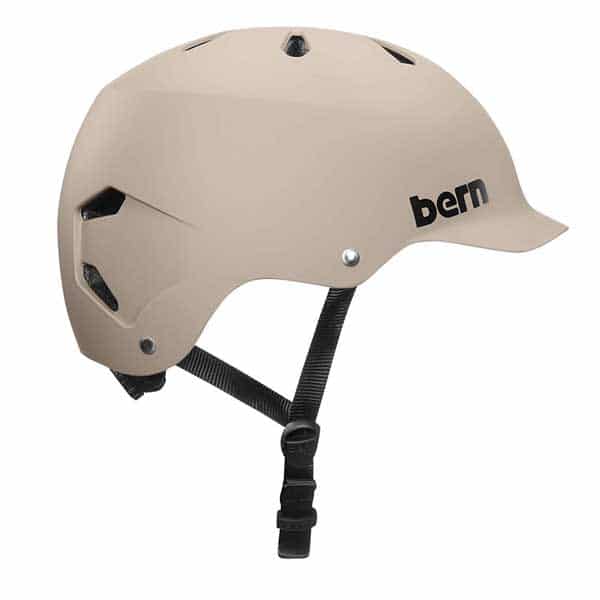
Price- $60 – $80 (size dependant)
Check it out here on Amazon.
| Pros: |
| + Three times certified |
| + With special bike lights compatible |
| + customizable for different seasons |
| Cons: |
| – Small Air Vents |
SIZE CHART: To ensure a perfect fit, measure the circumference of your head starting in the middle of your forehead and match it with the sizes below:
| Size | Hat Size | cm |
| S | 6 1/2 – 7 | 52 – 55.5 cm |
| M | 7 – 7 3/8 | 55.5 – 59 cm |
| L | 7 3/8 – 7 7/8 | 59 – 62 cm |
Pro-Tech Classic Cert Helmet
The Pro-Tec helmet comes with ESP certified lining passing ASTM F1492 standards. Coming in a wide arrange of sizes, this helmet is cited as being a good option for those with bigger heads. With adjustable straps and compression-molded liner pads, this helmet contains decades of Pro-Tec heritage lending to its style and comfort.
The helmet passes safety certifications for CPSC, CE, ASTM, and AS/NZS. 2063:2008.
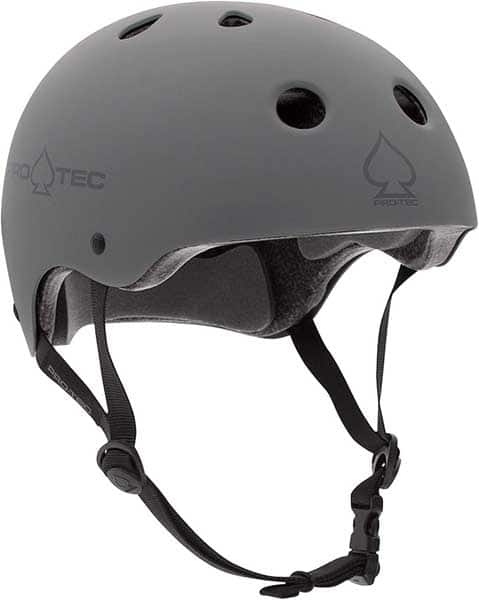
Price: $40–$65
Check it out here on Amazon.
| Pros: |
| + Multi-Certified |
| + Stylish |
| + 8 Air Vents |
| Cons: |
| – Some users report deteriorating liner pads |
| – Users report finding issue with lack of adjustment to the helmet |
Thousand Helmet
The Thousand helmet is a lightweight helmet at 410g (s) 450g (m) or 490g (l). It is built to meet CPSC and CE EN 1078 standards. The helmet includes 2 sets of interior padding for a great custom fit with a secret pop lock that allows you to lock your helmet with your cycle. It’s convenient, stylish and comfortable without compromising the safety!

Price: $90
Check this model here on Amazon.
| Pros: |
| + Dual certified |
| + Pop-hole to lock the helmet |
| + Stylish design |
| Very light |
| Cons: |
| – Almost no Air Vents |
| – Pricey |
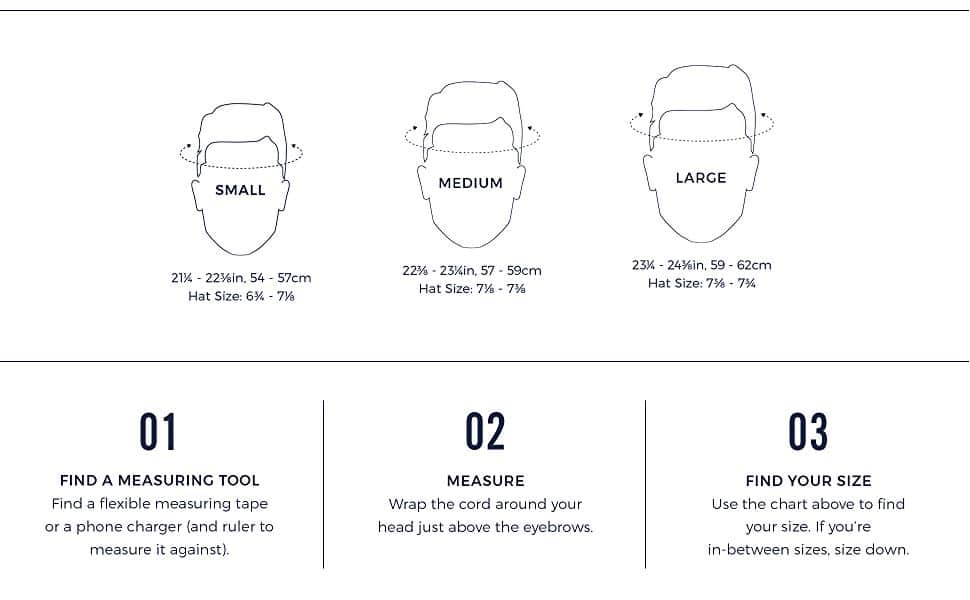
If you can’t choose between sizes, the company recommends taking a smaller size.
LED Helmets for Longboarding
LED Helmet Certifications:
| CPSC Standard | EN 1078 | ASTM F1492 | AS/NZS 2063 | MIPS Available | |
|---|---|---|---|---|---|
| Lumos Matrix | ✓ | ✓ | ✓ | ✓ | ✓ |
| Lumos Street | ✓ | ✓ | ✓ | ✓ | ✓ |
| Lumos Kickstart | ✓ | ✓ | ✓ | ✓ | ✓ |
New Lumos Helmets – Lumos Matrix and Lumos Street
The Lumos helmets have LED’s on the back and front of the helmet, aiding in your visibility during nightfall.
Lumos offers two models: the Lumos Matrix and Lumos Street, both practical to indicate turns and brakes with their new upgrades. While the Lumos Street only has here LED strips, a noticeable comparison to the Matrix with big LED panel with customizable backlighting modes, both models 10h battery runtime and a remote to indicate turns. Both helmets, despite these specs, are only a light 580g. That’s insanely light! The Lumos app can be connected to Google Fit and Apple Health to track your rides. Best of all, though, is that the Lumos helmets have four safety certificates: CPSC / F1492 / EN1078 / AS2063.

Lumos Original
The Lumos Original is an LED helmet with bright red lights in the back and while ones in the front, which will guarantee a safer ride. Furthermore, it has built-in accelerometers so that you have functioning brake lights. You can also indicate your turns with the blinking arrows on the helmet. It’s loved by most customers, boasting great reviews to mirror this.
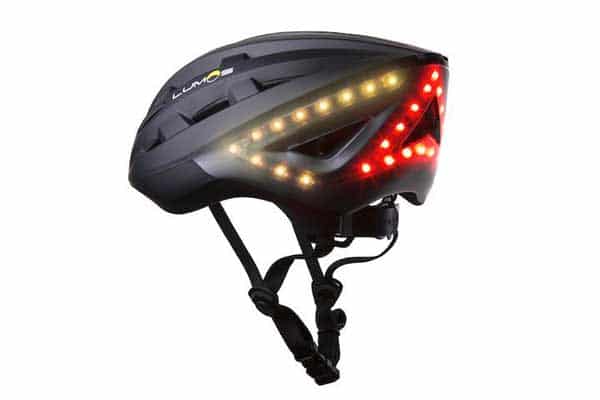
T2 Torch Bike Helmet
Like the Lumos helmet, the torch bike helmet comes with integrated LEDs. It has white LEDs on the front side and red LEDs on the backside. This will, of course, increase your visibility. It has up to 6h battery life, 36 on flash mode. It has a dial adjust system and comes with two sets of removable fit pads. It only weighs 360g.
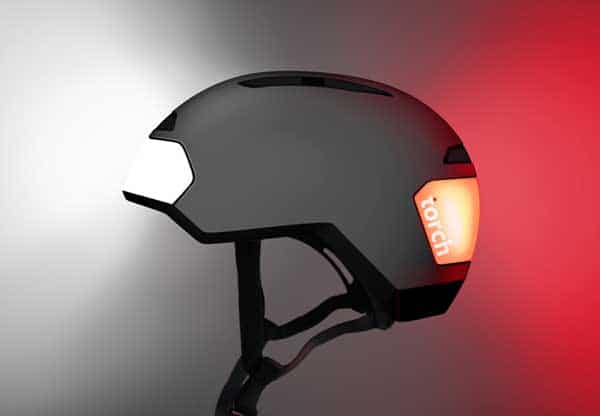
Foldable Longboard Helmets
Foldable Helmet Certifications:
| CPSC Standard | EN 1078 | |
|---|---|---|
| Morpher Helmet | ✓ | ✓ |
| Overade Plixi | ✓ | ✓ |
Morpher Helmet
Morpher is a helmet that when folded has four internal magnets that help to keep it flat. This means you can store it easily in your bag, avoiding bulky inconveniences! It started fundraising in 2013 weighs under 550g and Morpher offers a CPSC and EN1078 certified model.
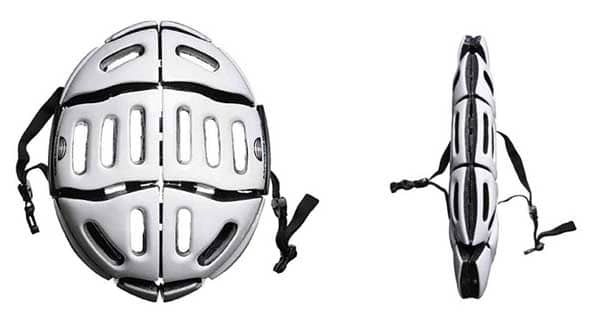
Overade Plixi
Overade has a folding hardshell helmet called the Plixi with a complex folding mechanism. It meets the CPSC and CEN helmet standards. Consumer reports rated its impact performance as ‘very good’ in their 2016 helmet article but downrated it for fit and ventilation. Overall, most reviews are positive giving kudos for the compact size and durability. However, some say that the helmet, despite being foldable, still comes off as too bulky and that the fit is uncomfortable.
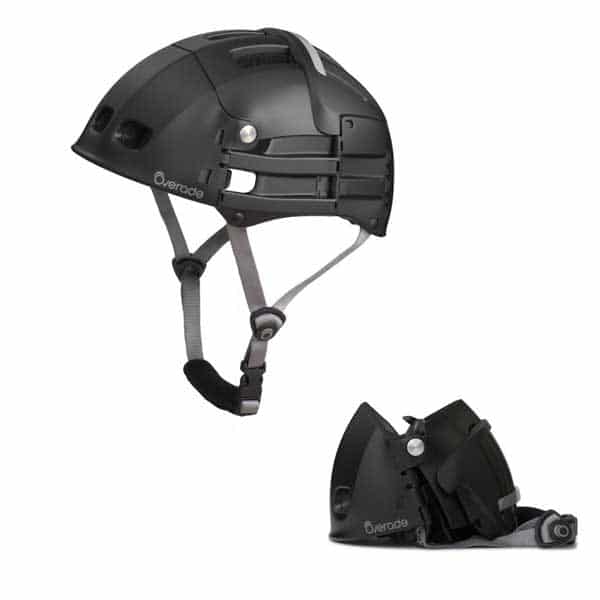
Check out my article on the best LIGHTNING solutions for longboards! To make sure you see and you also be seen!
Things to Consider Before Buying a Longboard Helmet
There are numerous essential factors to consider when choosing a helmet when Longboarding. Before you rush into the process looking for the best looking helmet, think about your purchase and how it can keep you safe and comfortable while riding.
- Half-shell or Full-face helmet? We can sort helmets into two categories: full-face and half/egg-shell helmets. High-performance riders often wear full-face helmets for additional protection to the jaw and skull. Daily commuters who don’t want to attract attention will still be safe wearing a half-shell helmet. If you ride at lower speeds or not very regularly and put emphasis on looking like the typical cyclist or skater, you can pick a half-shell helmet.
- Size and Fit: When picking the helmet it’s crucial to make sure it fits correctly and feels comfortable. Unlike your everyday beanie or cap, you can’t just let them sit however seems convenient.
- The measurements on the chart: Now that you’ve successfully measured the circumference of your head, you can begin shopping online for your helmet! For that, you just need to look at the size charts provided and look for your circumference.
- Tips for the Perfect Fit: An expensive helmet doesn’t always equal a comfortable one. To ensure your helmet has a perfect fit, you should primarily adjust the width of the helmet. This is most commonly done with an alterable strap.
- Check: Ideally, your helmet should not fall off if you shake your head or bend yourself over without closing the chin strap. Secondly, we adapt the chin strap: The chin straps should run flat and tightly past the ears down to the chin. One finger should advisably fit between the strap and your chin when the buckle is closed and the chin strap is adjusted accordingly.
- Check: This goes without saying, but with an adjusted and closed chin strap, you should not be able to pull the helmet away from or over your head.
- Speed: If you exceed speeds over 25 km/h (15 mph) then you should definitely get a full-face helmet. An impact at that speed can cause severe damage in places you’d probably prefer to keep healthy. You can break your jaw and other bones. This is a very serious injury and you want to make sure it won’t happen. At lower speeds, however, you’ll hopefully and most likely get away with a few bruises or scratches. Additionally, you might want to consider glasses or a helmet with a visor to protect your eyes from the wind. Without those, you could end up suffering from a constant, insufferable case of leaky tear ducts when riding. Not fun.
- Safety Standards: You’ve only got one brain so, at the chance of coming off too prescriptive, I’d suggest you take care of it. If you don’t you can kiss longboarding goodbye and say howdy to hospital food. I beg you, just protect yourself. “A helmet’s outer shell is usually made of polycarbonate plastic, kevlar or fiberglass. The core is generally constructed of polystyrene or polypropylene foam which upon impacts crushes. This process absorbs the energy that would otherwise have been forced upon your skull. So, after an impact (which can also occur if your helmet is dropped onto the pavement) it won’t be able to provide the expected level of protection even though the outer shell may still look like it’s in a good condition.”
The hard gray or black foam inside a helmet is called EPS (expanded polystyrene). EPS absorbs most of the impact force, so make sure your helmet’s EPS is certified by CPSC standards. The EPS being certified doesn’t mean the helmet is certified though, so be careful. You will likely come across these safety standards regarding helmets: - CPSC Standard: Safety Standard of “The United States Consumer Product Safety Commission” for Bicycle Helmets
- ASTM F1492: Standard specification for helmets used for Bicycling, Skateboarding, Trick Roller Skating
- ASTM F1952: Safety Standard for Downhill Mountain Bicycle Helmets
- ASTM F1447: Safety Standard for bicycle helmets
- Snell N-94: This Standard describes helmets for use in non-motorized sports which includes bicycling. Helmets certified to this Standard, by the fact of this certification, have met all the requirements for the Snell Memorial Foundation’s Standard for bicyclist helmets. The Snell Memorial Foundation, Inc. is a not-for-profit organization dedicated to research, education, testing and development of helmet safety standards.
- EN 1078: European Safety Standard for Helmets for pedal cyclists, skateboarders, & roller skaters
- AS/NZS 2063: Australian/New Zealand Safety Standard for Bicycle helmets.
IMPORTANT! Make sure at the LEAST that the helmet has the weakest certification. The bare minimum is the ATSM F1492 certification for helmets.
- New vs. Second Hand: Before we delve deeper, do not buy a second-hand/used helmet. Not only will you be sharing some sweat with the previous owner, but far more paramount is that the structural integrity of the helmet may have already been compromised with a fall. Helmets need to be replaced regularly to keep that structural integrity sound and that can’t be ensured using a second-hand helmet.
- Field of View: The field of view is fairly important for a longboarder, so be sure you’re able to detect holes and cracks in the pavement to either avoid or brace for them, depending on the occasion. Additionally, f you ride in urban areas, the field of view aspect is much more important as you constantly need to look out for traffic.
- Weight: No one likes a heavy helmet! A heavy helmet will make you tired when riding for lengthy periods of time. Your neck will thank you if you pick a more lightweight helmet.
- Price: You will often be guaranteed the bang for the buck if you purchase a helmet by a known, trusted brand, even if it is a bit more pricey. It’s not wise to skimp out on the safety of your head. This head is the only one you’ve got, so protect it by any means necessary.
- A half lid helmet will normally set you back $30-90
- A full-face helmet may cost anywhere between $150-400
- Design and Graphics: Getting a helmet you don’t vibe with or dislike the look of is a surefire way to neglect it more often. The graphics may not add safety, but sometimes it’s worth the extra time or money to get that special helmet if it means you’ll love wearing it.
- Climate / Weather: You should definitely keep climate in mind when purchasing a helmet. If you live in a hot area, many well-placed air vents and sweat liners are imperative. If you live somewhere with a much colder climate, a warm, isolating helmet with fewer air vents may be more appropriate.
- Cooling and Air Vents: Air vents are the holes that you see on and around the helmets. These vents function as the cooling system for your helmet. The size and number of vents on each helmet will vary between brands. These vents are very important. A ride in the middle of the summer is very uncomfortable without decent ventilation on your helmet.
- Sweat Liners: During any kind of physical activity, you can expect to sweat and this includes Longboarding. The sweat liner helps to minimize the amount of sweat that runs down your face while you cycle. One thing to note is that sweat liners should be replaced frequently to prevent the spread of bacteria.
- Why Not Use a Motorcycle Helmet? Motorcycle helmets are designed for crashes exceeding 65 mph. Due to this, they have a lot of EPS foam for appropriate protection, but this makes them very heavy. When it comes to skating, motorcycle helmets are overkill. They have a bad field of view, are uncomfortable to wear, and may make your head very stiff.
- Helmet Types That Do Work
- Bicycle helmets
- Skateboard helmets
- Longboard helmets
When Should I Replace My Longboard Helmet?
Helmets are built to sustain and survive a considerable amount of abuse, but you should never wait until it’s practically threadbare before making a new purchase.
Manufacturers recommend replacing a helmet after 3-5 years of use, or 7 years after the production date of the helmet. They also advise making a new helmet purchase if it ever sustains significant damage from a collision.
A bike, skateboard or longboard helmet aren’t designed to withstand more than one impact, as it crushes under the blow when it absorbs the pressure of the impact a skull might’ve otherwise sustained. As such, the damaged area of one of these helmets is not designed to absorb another hit.
Should I Replace a Helmet After Dropping It?
”Generally the answer is probably not. Helmets are one-use items, but are quite durable otherwise, at least the ones we certify. Frequent dropping or spiking a helmet on the ground, or other hard surfaces may eventually degrade the helmet’s performance. Similarly, if the helmet falls to the ground at highway speeds unoccupied, the owner must be aware that some degradation may have occurred. In general, the real damage comes when the helmet contacts an object with a head inside”
Summary:
- Did you crash? Replace it.
- Did you somehow drop it hard enough to crack the foam? Replace it.
- Is it from the ’80s? Dude… please just replace it.
- Is it just the outside foam or cloth instead of plastic. Replace it!
- Still can’t get it to fit correctly? I beg you, replace it.
- Do you still like wearing it? If not, it’s time for a new one!
Final Thoughts – Now it’s Your Turn
When buying and wearing a helmet while Longboarding the inner monologue generally used to sound something akin to this:
“But I look like an idiot and helmets aren’t cool!”
These types of views were often echoed by our surroundings.
Nowadays, the reverse scenario is more common, to be frank. A rider without headgear seems heedless and idiotic because they are either naive enough or arrogant to the dangers involved. You will often exceed speeds of 10 mph. You’re riding on hard pavement. Every fall can cause severe damage to your body or brain. It can happen. You’re not immune to accidents, slip-ups and to other’s foolish way of behaving in traffic. Please. Wear a helmet.
Thank you for reading! If you have recommendations for other helmets I’d love to read them. If you feel I should have included something else, please send some feedback! It’s how we all grow! Now it’s your turn!
Which helmet do you like most and why?
Let me know in the comment section down below!
